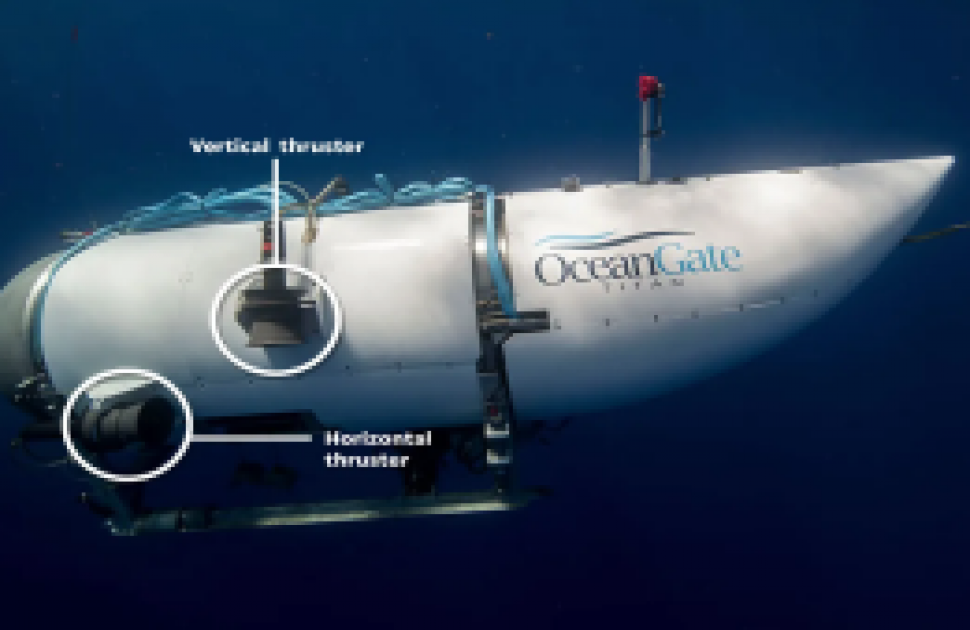Submersibles have played a vital role in deep-sea exploration. Their use has enabled us to make extraordinary revelations, such as that of the Titanic wreckage. Having met its unfortunate end in 1912, the remains of the legendary ship had remained undiscovered for around 70 years before submersibles made it possible for mankind to venture deeper into the abyss of the ocean.
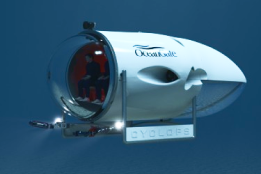
Representation of the Cyclops 1, produced by OceanGate (Image credit: https://washington.edu/news/2013/10/08/uw-local-company-building-innovative-deep-sea-manned-submarine/)
Submersibles have created opportunities to unravel the mysteries of the deep, dark, and cold oceans. The Titanic wreckage has been frequented by researchers, scientists, and enthusiasts since the successful journey of DSV Alvin. DSV stands for deep submergence vehicle, and its expeditions to the wreckage site provided crucial data and documentation of the condition and wear of the remnants of the ship on the ocean floor.
OceanGate Inc. is a private organization, specializing in oceanic exploration and manned submersible technology. The company owns a fleet of manually operated submersibles that permit deep-sea exploration and are often utilized for marine research, environmental studies, deep-sea or underwater inspections, and the exploration of historically significant shipwrecks.
OceanGate Inc. recently made headlines in the news for the unforeseen implosion of its submersible, Titan, formerly called Cyclops 2, which led to the demise of the five passengers onboard, including the CEO of the organization, Stockton Rush.
Overview of the Titan Submarine and its Purpose
The Titan submersible was a remarkable submersible developed and engineered by OceanGate Inc. in conjunction with NASA, Boeing, and the University of Washington. This was the world’s only carbon-fiber submersible that could carry five people to depths of 4000 meters (13,123 feet). Specifically used in deep-sea exploration, the Titan played a significant role in the annual Titanic expeditions for surveying the wreck of the RMS Titanic.
One of the distinctive attributes of the Titan was its ability to carry a larger crew, allowing for the participation of multiple mission specialists, scientists, and content experts to embark on a rare and memorable deep-ocean diving experience.
The Titan debuted in 2018, displaying cutting-edge technology and employing advanced materials, such as carbon fiber, resulting in a lighter weight than other deep-diving submersibles. This approach to its construction permitted a more spacious and comfortable interior, that enhanced the overall diving experience for its passengers.
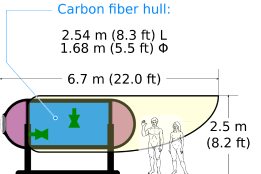
Representation of the Cyclops 1, produced by OceanGate (Image credit: https://washington.edu/news/2013/10/08/uw-local-company-building-innovative-deep-sea-manned-submarine/)
The Titan submersible was furnished with high-tech lighting and SONAR navigation systems. It was also equipped with 4K video and photography gear, mounted both internally and externally. The interiors were said to have sufficient space for extra monitoring, inspection, and data collection equipment. This facilitated direct observation, inspection, and exploration of the deep recesses of the sea.
- The salient features of the Titan build and design, as specified by the specification sheet issued by OceanGate Inc. include the following:
- The dimensions of the Titan submersible spanned 22ft x 9.2ft x 8.3 ft, offering restricted room to the passengers. The crew would include one pilot and up to four crew members.
- Weighing 9,525 kgs or 21,000 lbs, the Titan could carry a payload of up to 685 kgs or 1,510 lbs and has a speed of 3 knots.
- The propulsion of the submersible was powered by four 1002 series electric thrusters made by Innerspace Corporation. This included two vertical and two horizontal thrusters.
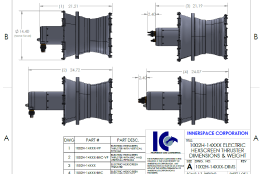
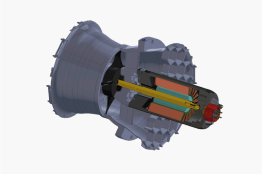
1002 series electric thrusters by Innerspace corporation. (Image credit: https://innerspacethrusters.com/products/electric/model-1002-series/)
- The life support provided by the Titan submersible could last for 96 hours for a crew of five members.
- The navigation technology included the BlueView 2D SONAR, built by Teledyne Marine, as well as the Teledyne 6000m RDI phased array Pioneer Doppler Velocity Log (DVL), with XRT extended tracking and Ultra-Short Baseline (USBL) internal navigation systems (INS).
- The lighting systems consisted of four LED Sealites manufactured by DeepSea Power and Light that provide a total output of 40,000 Lumens.
- The Titan was fitted with a 380-mm acrylic viewport, said to be double that of any competing submersible, providing unparalleled views to the passengers.
- The visual data collection mechanism involved the use of the Rayfin Subsea 4K camera (produced by SubC imaging) and three axis-cameras.
The Titan submersible was also equipped with the ULS-500 PRO, produced by 2G Robotics, which is a laser scanner that can help provide information for high-tolerance subsea metrology, damage detection and assessment, installation repair and maintenance, and as-built surveying.
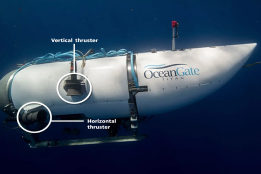
(Image credit: https://www.usatoday.com/story/graphics/2023/06/21/titanicsubmarine-missing-titan-submersible/70340478007/)
Despite the numerous technical redundancies in place, catastrophes can seldom be prevented when faced with unforeseen environmental and logistical variables that may have yet to be accounted for. To understand and solidify measures to prevent incidents such as the implosion of the Titan submersible, there should be a chronological evaluation of the events which led to the subsequent implosion is imperative.
Detailed timeline of the incident, from initial reports to the implosion
The series of events that led to the catastrophic implosion are speculated to be as follows:
- Mission 1: Scheduled for May 11-19th, 2023, was unsuccessful due to poor weather conditions.
- Mission 2: Scheduled for May 20-28th, 2023, was also unsuccessful due to poor weather conditions.
- A dive attempt was made on 23rd May 2023 but failed due to technical issues with the launch platform.
- Mission 3: Scheduled for May 29-June 6th, 2023, but to no success as the test dive had to be aborted due to computer systems troubles and poor weather conditions.
- Mission 4: Scheduled for June 7-15th, 2023, was unsuccessful due to poor weather conditions.
- Mission 5: Scheduled for June 16-24th, 2023.
- The dive was attempted on 18th June 2023.
-> 8:00 ET- Titan is scheduled to start descent but was delayed.
->12:00- Titan dive began.
-> 13:45- Communication was lost between Titan and the Polar Prince, the Titan’s support vessel.
->Acoustic anomaly is detected by the US Navy
->15:00- The Titan was expected to resurface, however, it failed to appear.
->17:40- The Coast Guard was notified of the delay by the Polar Prince.
- By June 19th, search and rescue missions were operational, and planes and ships from the USA and Canada were scouting the area for signs of the Titan. It was announced that the submersible may be left with approximately 70-96 hours of oxygen.
- June 20th- France joined the search efforts by deploying the Atalante, a deep-sea diving vessel.
-> The Canadian Lockheed P-3 Orion aircraft detected sounds over a period.
-> The sounds were said to have been detected at 30-minute intervals.
-> Many international ships, underwater vessels, and aircraft joined the mission.
- June 21st- A unified command of the US Coast Guard, Canadian Coast Guard, US Navy, and OceanGate set out to handle the search.
-> It was announced that the Canadian P-3 aircraft detected noises underwater and ROVs were being utilized to scope the area. The data obtained was sent to the US Navy for analysis.
- June 22nd- As per, US Coast Guard estimates, the oxygen in the submersible was expected to run out.
-> A debris field containing pieces of the submersible was found near the Titanic wreckage in the North Atlantic Ocean.
-> The debris field indicated the loss of the pressure chamber and there was evidence of an implosion.
The crew of the missing Titanic submersible was hence believed to be dead.
Explanation of the implosion of the Titan submersible
The destruction of the Titan submersible was said to have been caused by a ‘catastrophic implosion’. This would entail destruction under tremendous power and swiftness, considering the immense water pressure of the ocean floor.
The wreckage of the Titanic rests approximately 12,400 ft deep on the seabed of the North Atlantic. While the atmospheric pressure at sea level is about 14.7 psi, the water pressure at the Titanic's location reaches an immense 6,000 psi (equivalent to 400 atmospheres).
It is postulated that the implosion was caused due to a defect in the hull. In such a scenario, the Titan would have collapsed in on itself in a fraction of a second, being crushed by the surrounding pressure.
A thorough analysis of the debris retrieved will be the only way to confirm the cause of the unfortunate incident, shining a light on the reason for the failure of the vehicle.
Many questions had been raised before the incident, regarding the safety of the Titan submersible. The carbon fiber composite cylinder, consisting of titanium end caps was a matter of concern to many experts. The external pressure of the working environment of the Titan was bound to deteriorate the integrity of the vessel with every dive.
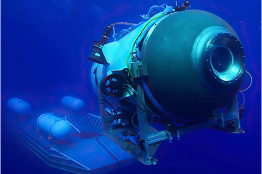
(Image credit: https://www.scientificamerican.com/article/what-safety features-should-subs-titan-be-equipped-with/)
Carbon-fiber composites are stiffer and less elastic than Titanium, which can adapt to pressure forces by shrinking. The differences in materials may have caused a loss of integrity, causing delamination of the composite material. Delamination may result in the separation of the layers of reinforcement.
The delamination of the composite may have led to defect formation, causing an instant failure and subsequent implosion due to the high environmental pressures. The newer design and hull material exacerbated the need for extensive testing.
It was also revealed that the submersible had not followed certain safety codes and had not undergone certification. Experts in the industry had issued warnings to OceanGate about the safety of the vehicle, which was disregarded by the organization.
How NDT could have prevented the incident
Ocean Gate’s former Director of Marine Operations, David Lochridge filed an OSHA complaint in 2018, stating that the testing of the hull was insufficient to determine the defects and deformities present. He noted that this inadequate testing could potentially cause a disaster.
Lochridge emphasized the use of Non-destructive testing methods, calling them critical in ensuring a stable and safe vehicle for the safety of the crew onboard. Lochridge was fired after he refused to accept reassurances from the lead engineer about the safety of the procedure.
Multiple experts and ex-passengers of the Titan submersible raised concerns about its safety. Despite these concerns, OceanGate proceeded to transport passengers without addressing the importance of comprehensive non-destructive testing and analysis for a vital vehicle such as the Titan submersible. Regrettably, the passengers remained unaware of the company's negligence in this regard.
By omitting NDT in the manufacturing process of a submersible, the chances of undetected defects rise, leading to compromised structural integrity and substantial risks to the submersible's safety, performance, and longevity.
Non-destructive testing methods that are commonly used in the production and assessment of submersibles include:
- Visual Inspection
- Ultrasonic Testing
- Magnetic Particle Testing
- Dye Penetrant Testing
- Radiographic Testing
- Eddy Current Testing
- Pressure Testing
Advanced NDT methods like Phased Array Ultrasonic Testing, Pulsed Thermography, Laser Shearography, etc. may also be employed to detect hidden flaws or material defects that may negatively impact the submersibles' integrity.
Implementing responsible engineering practices, such as thorough and timely inspections, non-destructive testing, pressure testing of components, functionality and performance testing, and validation of design modifications, can enhance the future of deep-sea vehicles and reduce the likelihood of a similar incident happening again.
Engineering Lessons Learned
The Titan submersible may have been one of the most significant engineering failures of 2023, but it taught us some somber but vital lessons to pay heed to in the future:
- The implosion of the Titan submersible emphasizes the need to give precedence to the safety and execution of reliable risk-management methods. The field of deep-sea research and engineering is laden with hazards, hence, stringent safety measures, meticulous and timely inspection of equipment, and emergency plans need to be ensured.
- Equipment and vehicles used in harsh environments need to undergo precise engineering design, testing, and manufacturing. Detailed testing, using destructive and non-destructive testing methods should be carried out at various points of the design and manufacturing process to ensure their reliability in extreme operating conditions.
- Kaizen or continuous improvement should be implemented, and notes should be taken from failures. Failure assessment and investigations should be conducted to gather data from the Titan’s debris to improve equipment, safety considerations, and operating procedures for future missions.
- Prompt emergency response in the event of such incidents should be pre-determined. Incidents such as the Titan implosion highlight the limitations in technology, communication systems, and accessibility. Emergency measures should be well planned to curb losses and potentially avoid disasters of this magnitude.
- The implosion of the Titan submersible underscores the need to improve cooperation between researchers, engineers, deep-sea industries, and various other experts. Sharing the lessons learned from failures, technology, and optimal approaches can lead to collective growth and consequentially overall progress in deep-sea exploration.
Conclusion
In the aftermath of the Titan submersible disaster, the lessons learned will reverberate through time. This incident will remind us of the significance of safety, effective information exchange, oversight, and advancement of technology.
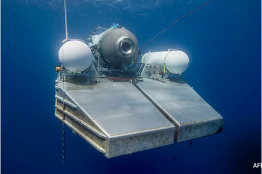
(Image credit: https://www.ndtv.com/world-news/titan-submersible-what-is-acatastrophic-implosion-likely-cause-of-titan-subs-destruction-4145349)
The fatal implosion of the Titan submersible has raised important questions about the reliability and future of deep-sea vehicles. The need for regulations and adherence to safety codes and design principles such as that of the US Navy known as SUBSAFE were highlighted.
Emphasis has been made on the need to avoid bypassing standards and compromising safety due to the apprehension of hindering innovation. OceanGate could have evaded this tragically unfortunate event by paying heed to the concerns of the multiple experts, engineers, and employees who raised concerns about the design, safety, and operation of the Titan submersible.
Armed with this knowledge, we can ensure that future calamities of this nature are averted. This wisdom secures the safety of those who traverse the oceans and seas.
The past must be honored by paving the way for a future where every voyage comes with a promise of the welfare and security of all.
